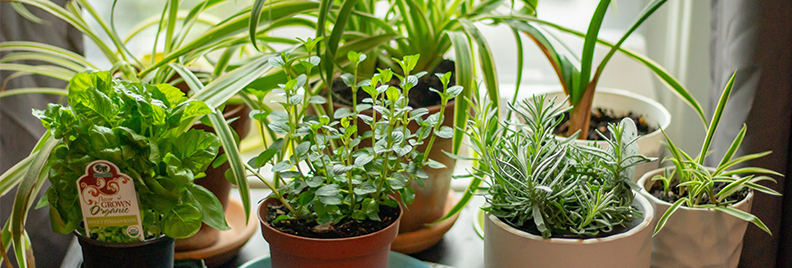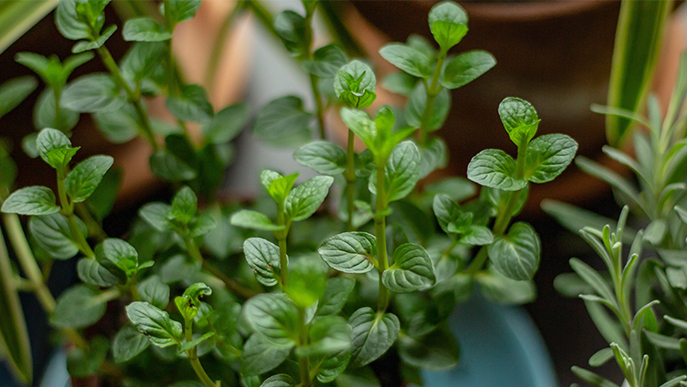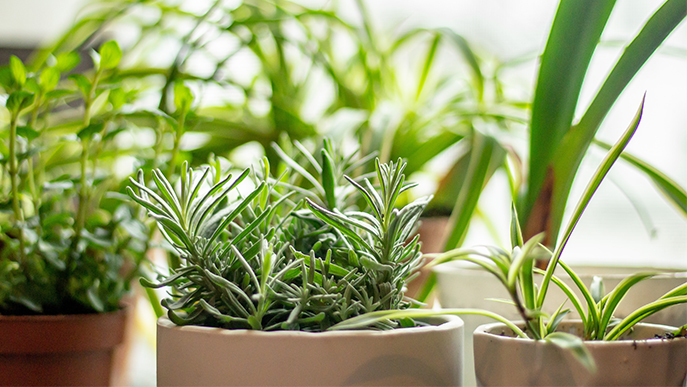
Herb Gardening Basics
Herb Gardening for Beginners: Seed Sprouting
Growing an Herb Garden in Your Kitchen
The Best Plants for Houston Herb Gardening
If you’re a newbie gardener here in Houston and you’re looking for an easy first-timer gardening project, look no further than herb gardening. Honestly, growing a herb garden at home is a tiny investment with a huge return, and you’ll love what it adds to the quality of your cooking. Nothing beats having a steady supply of garden-fresh herbs for all your meals and fancy cocktails (and you have to admit, it’s pretty satisfying to proclaim at dinner parties that you personally grew the mint for the pineapple mojitos). We’ve outlined all the herb gardening basics so you can get started on creating a living spice rack that beats the store-bought stuff any day of the week.

Herb Gardening for Beginners: Seed Sprouting
Starting seeds for a herb garden isn’t too difficult— the key is to make sure the soil remains moist for that first week of germination. Fill small cups with potting soil and press 2 seeds of your choice into each cup, then moisten the soil with some water (but don’t go overboard with it). Be sure to check the seed packet in case there are any special planting instructions for the herb you’ve chosen. Once they start to grow, pluck out the weaker one and keep the stronger one.
You can pick up biodegradable paper-based seed cups that allow for great soil drainage as your seedling develops its roots, but keep in mind that the porous nature of the material will cause the soil to dry faster. You’ll need to be really diligent with watering for that first week. A spot near a sunny window might end up evaporating moisture pretty quickly, so avoid keeping them in direct sunlight until you start to see the first leaves poking out. Alternatively, if you’ve got an old espresso cup set that you never use, or some souvenir shot glasses from Puerto Vallarta, those make great seed starter cups that retain moisture well. Just be sure not to overwater, or you might run into issues with mold.
Once your baby plants are a couple of inches tall, transfer them to bigger containers so they can start spreading. With lots of sunshine and regular watering, you’ll have plenty to harvest in no time. Some herbs literally grow like weeds, so in the sunny Houston summer months, they can get pretty crazy


Growing an Herb Garden in Your Kitchen
One of the best parts about herb gardening is that you can enjoy it even if you don’t have a big yard for a garden, so these gardens are a good fit for apartment-dwellers. Herb planters are generally pretty compact and can easily fit on windowsills or in hanging displays, so you can set one up right in your kitchen. This way, your herbs are right there when you need them, so you can pick, rinse, and toss ‘em in the sauce in mere seconds.
To save even more room in your kitchen but still create a decked-out herb garden with tons of variety, you can build a suspended window herb garden. Install a few slim bars or curtain rods across the length of your window about one foot apart, then pick up a bunch of small planters with ropes or hooks that you can hang from the bars. Once your herb planters are growing, it creates a sweet window display that’s just as useful as it is stylish.
Outdoor Herb Gardening Tips
Growing herbs in the garden has multiple benefits. Not only do they make great groundcover plants to fill in gaps between more flashy florals, but a lot of fragrant herbs are also excellent pest repellents. Herbs like basil and mint are great at keeping bugs away, as well as hungry rabbits and deer that chow down on our vegetable plants.
Always take into consideration the sunlight requirements for your chosen herbs. Some prefer partial or dappled shade over direct sunlight, so try to plant them in a spot with ideal light conditions. You can always grow herbs in outdoor containers as well, and then you have the ability to move the planter around the yard freely depending on how it’s responding to sunlight levels.

The Best Plants for Houston Herb Gardening
When deciding which herbs to include in your herb garden, you may as well stick with herbs that you tend to use a lot of already. Take note of the styles of cuisine and the types of spice blends you usually gravitate towards. If you need a little inspo for which plants to include in your herb garden, we’ve listed a few good starter options and the kinds of dishes you can use them in:
Mint: This fast-spreading herb will provide loads of fresh leaves to use in both savory and sweet cooking. Of course, the multitude of cocktails you can create with mint is totally amazeballs, but there are also some pretty exotic meals you can create using mint. Vietnamese salad rolls, Greek souvlaki with mint yogurt sauce, or watermelon feta mint salad are all delicious ways to make use of the huge harvests you’ll get from your mint plant.
Basil: A total staple in Italian and Thai cooking, this herb is actually part of the mint family, so it grows quite similarly. Add it to marinara, pesto, or coconut curry for fragrant, full-bodied flavor. Chop and mix it into blueberry jam for a fresh twist, or sprinkle freshly chopped leaves on pork tenderloin for a tasty garnish.
Rosemary: If you’re big on roasting meats at home, rosemary is a must-have. Not only does it add a mouth-watering aroma to roast beef, chicken, and pork dishes, but it can also be used in sweeter glazes for desserts. Rosemary honey butter glazes can be used on cakes, donuts, and even pretzels for a highly satisfying salty-sweet combo.
Chives: The skinny green stems and fluffy purple flowers are both edible parts of the chive plant. They have a tasty garlicky-onion flavor that works in a huge range of recipes. Mince them up and sprinkle into pretty much any dish that would typically contain garlic or onion (which is like, a lot, so you’ll get a ton of use out of your chives).
Cilantro: You either love it or hate it, but there’s no denying this leafy herb is a quintessential Mexican flavor. If taco Tuesdays are a big thing in your house, a sprinkle of fresh cilantro will go a long way.
Dill: The unmistakable tangy zest of dill adds a distinct pop of flavor to so many dishes, especially root vegetables. A sweet dill butter glaze will take roasted carrots, potatoes and beets to the next level.
Herb gardening is one of the best ways to get restaurant-quality flavor in your cooking right at home. Fresh garden herbs last so much longer than the store-bought variety, are less expensive, and have way better flavor than dried spice mixes. Get started on your new culinary project by picking up an herb garden kit from Plants for All Seasons and have fun deciding which seeds to sprout!

Comments (2)
Excellent articles. I love using fresh herbs in my cooking. It was mentioned that sunlight requirements are not the same for all herbs. Please do an article on the herbs and their different light and water requirements. Thanks
Thanks Diane!!! I will add this to our list of topics:-)
Comments are closed.